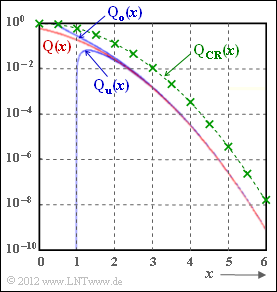Difference between revisions of "Aufgaben:Exercise 1.16Z: Bounds for the Gaussian Error Function"
| Line 33: | Line 33: | ||
Hints: | Hints: | ||
| − | * This exercise belongs to the chapter [[Channel_Coding/Bounds_for_Block_Error_Probability|"Bounds for | + | * This exercise belongs to the chapter [[Channel_Coding/Bounds_for_Block_Error_Probability|"Bounds for block error probability"]]. |
*Reference is also made to the chapter [[Theory_of_Stochastic_Signals/Gaussian_Distributed_Random_Variables|"Gaussian distributed random variables"]] in the book "Stochastic Signal Theory". | *Reference is also made to the chapter [[Theory_of_Stochastic_Signals/Gaussian_Distributed_Random_Variables|"Gaussian distributed random variables"]] in the book "Stochastic Signal Theory". | ||
Revision as of 16:15, 5 August 2022
The probability that a zero-mean Gaussian random variable $n$ with standard deviation $\sigma$ ⇒ variance $\sigma^2$ is greater in amount than a given value $A$ is equal to
- $${\rm Pr}(n > A) = {\rm Pr}(n < -A) ={\rm Q}(A/\sigma) \hspace{0.05cm}.$$
Here is used one of the most important functions for Communications Engineering (drawn in red in the diagram):
the "complementary Gaussian error function"
- $${\rm Q} (x) = \frac{\rm 1}{\sqrt{\rm 2\pi}}\int_{\it x}^{+\infty}\rm e^{\it -u^{\rm 2}/\rm 2}\,d \it u \hspace{0.05cm}.$$
${\rm Q}(x)$ is a monotonically decreasing function with ${\rm Q}(0) = 0.5$. For very large values of $x$ ⇒ ${\rm Q}(x)$ tends $\to 0$.
The integral of the ${\rm Q}$–function is not analytically solvable and is usually given in tabular form. From the literature, however, manageable approximations or bounds for positive $x$ values are known:
- the "upper bound" ⇒ upper $($German: "obere" ⇒ subscript: "o"$)$ blue curve in adjacent graph, valid for $x > 0$:
- $$ {\rm Q_o}(x)=\frac{\rm 1}{\sqrt{\rm 2\pi}\cdot x}\cdot {\rm e}^{-x^{\rm 2}/\rm 2}\hspace{0.15cm} \ge \hspace{0.15cm} {\rm Q} (x) \hspace{0.05cm},$$
- the "lower bound" ⇒ upper $($German: "untere" ⇒ subscript: "u"$)$ blue curve in adjacent graph, valid for $x > 1$:
- $$ {\rm Q_u}(x)=\frac{\rm 1-{\rm 1}/{\it x^{\rm 2}}}{\sqrt{\rm 2\pi}\cdot x}\cdot \rm e^{-x^{\rm 2}/\rm 2} \hspace{0.15cm} \le \hspace{0.15cm} {\rm Q} (x) \hspace{0.05cm},$$
- the "Chernoff-Rubin bound" $($green curve in the graph, drawn for $K = 1)$:
- $${\rm Q_{CR}}(x)=K \cdot {\rm e}^{-x^{\rm 2}/\rm 2} \hspace{0.15cm} \ge \hspace{0.15cm} {\rm Q} (x) \hspace{0.05cm}.$$
In the exercise it is to be investigated to what extent these bounds can be used as approximations for ${\rm Q}(x)$ and what corruptions result.
Hints:
- This exercise belongs to the chapter "Bounds for block error probability".
- Reference is also made to the chapter "Gaussian distributed random variables" in the book "Stochastic Signal Theory".
- The exercise provides some important hints for solving "Exercise 1.16", in which ${\rm Q}_{\rm CR}(x)$ is used to derive the "Bhattacharyya Bound" for the AWGN channel.
- Further we refer to the interactive applet "Complementary Gaussian error functions".
Questions
Solution
- $${\rm Q_o}(x)=\frac{1}{\sqrt{\rm 2\pi}\cdot x}\cdot {\rm e}^{-x^{\rm 2}/\rm 2} \hspace{0.3cm} \Rightarrow \hspace{0.3cm} {\rm Q_o}(4 )=\frac{1}{\sqrt{\rm 2\pi}\cdot 4}\cdot {\rm e}^{-8 }\hspace{0.15cm}\underline{\approx 3.346 \cdot 10^{-5}}\hspace{0.05cm}.$$
The lower bound can be converted as follows:
- $${\rm Q_u}( x)=(1-1/x^2) \cdot {\rm Q_o}(x) \hspace{0.3cm} \Rightarrow \hspace{0.3cm} {\rm Q_u}(4 ) \hspace{0.15cm}\underline{\approx 3.137 \cdot 10^{-5}} \hspace{0.05cm}.$$
- The relative deviations from the "real" value ${\rm Q}(4) = 3.167 · 10^{–5}$ sind $+5\%$ bzw. $–1\%$.
(2) Correct are the solutions 1 and 2:
- For $x = 2$, the actual function value ${\rm Q}(x) = 2.275 - 10^{-2}$ is bounded by ${\rm Q_{o}}(x) = 2.7 - 10^{-2}$ and ${\rm Q_u}(x) = 2.025 - 10^{-2}$, respectively.
- The relative deviations are therefore $18.7\%$ and $-11\%,$ respectively.
- The last statement is wrong: Only for $x < 0.37$ ${\rm Q_o}(x) > 1$ is valid.
(3) For the quotient of ${\rm Q}_{\rm CR}(x)$ and ${\rm Q_o}(x)$, according to the given equations:
- $$q(x) = \frac{{\rm Q_{CR}}(x)}{{\rm Q_{o}}(x)} = \frac{{\rm exp}(-x^2/2)}{{\rm exp}(-x^2/2)/({\sqrt{2\pi} \cdot x})} = {\sqrt{2\pi} \cdot x}$$
- $$\Rightarrow \hspace{0.3cm} q(x) \approx 2.5 \cdot x \hspace{0.3cm} \Rightarrow \hspace{0.3cm} q(x =2) \hspace{0.15cm}\underline{=5}\hspace{0.05cm}, \hspace{0.2cm}q(x =4)\hspace{0.15cm}\underline{=10}\hspace{0.05cm}, \hspace{0.2cm}q(x =6) \hspace{0.15cm}\underline{=15}\hspace{0.05cm}.$$
- The larger the abscissa value $x$ is, the more inaccurately ${\rm Q}(x)$ is approximated by ${\rm Q}_{\rm CR}(x)$.
- When looking at the graph on the information page, one has (I had) the impression that ${\rm Q}_{\rm CR}(x)$ results from ${\rm Q}(x)$ by shifting down or shifting up. But this is only an optical illusion and does not correspond to the facts.
(4) With $\underline{K = 0.5}$ the new bound $0.5 - {\rm Q}_{\rm CR}(x)$ for $x = 0$ agrees exactly with ${\rm Q}(x=0) = 0.500$.
- For larger abscissa values, the corruption $q \approx 1.25 - x$ thus also becomes only half as large.
